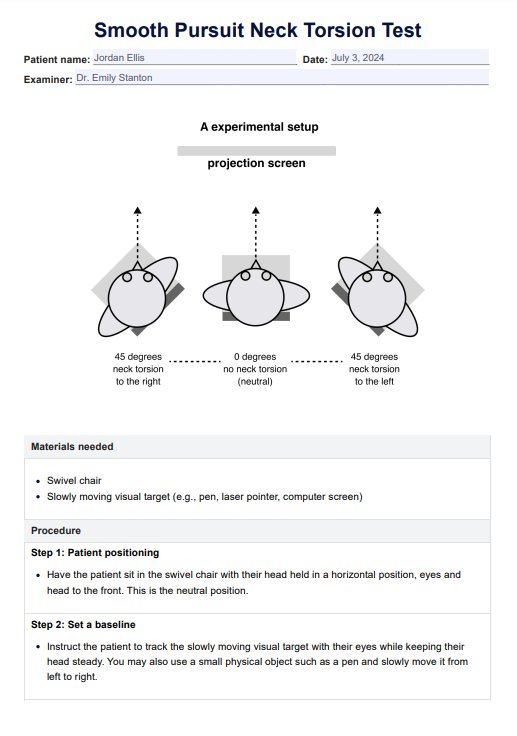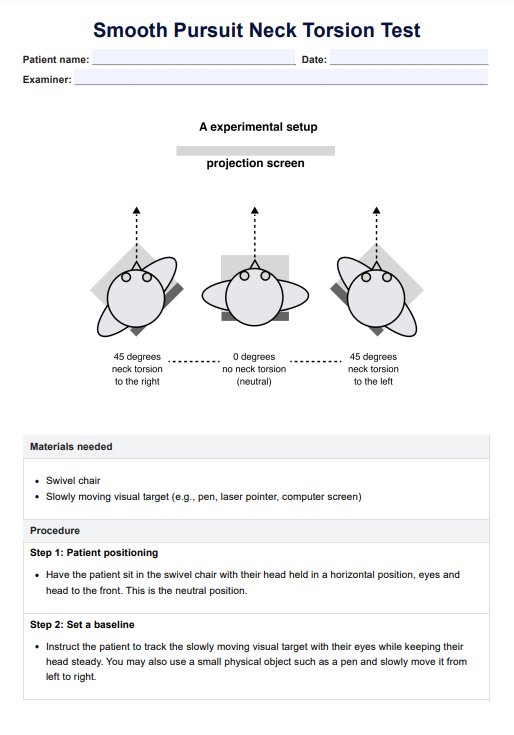Smooth Pursuit Neck Torsion Test
Explore our free Smooth Pursuit Neck Torsion Test template to diagnose cervicogenic dizziness with detailed steps and examples accurately.


What is cervicogenic dizziness?
Cervicogenic dizziness, also known as cervical dizziness, is a type of dizziness that originates from issues in the cervical spine, the upper portion of the spine located in the neck. It is often associated with neck pain and discomfort and occurs when dysfunction in the cervical vertebrae or soft tissues occurs, especially in cases of whiplash-associated disorders. This form of dizziness is particularly noted in patients who have experienced neck injuries, whiplash, or other chronic neck pain problems and affects many chronic neck pain patients.
Symptoms of this kind of dizziness
The symptoms of cervicogenic dizziness can vary but typically include:
- A sensation or dizziness, often triggered or worsened by neck movements or positions, is especially pronounced when neck pain is present
- Neck pain and stiffness, as well as various neck pain disorders, which may radiate to the shoulders, are commonly found in neck pain patients
- Headaches, commonly felt at the back of the head
- Difficulty in maintaining balance, especially when moving the head
- Blurred vision or visual disturbances are particularly associated with neck movement
- Patients might also experience upper extremities pain, which can accompany the stiffness and discomfort in the neck
Causes of this dizziness
The causes of cervicogenic dizziness are generally linked to issues in the cervical spine. These may include:
- Misalignment or dysfunction of cervical vertebrae or muscle strain, particularly in cases of chronic idiopathic neck pain
- Muscle strain or sprains in the neck region
- Injuries such as whiplash, which impact the neck’s muscles, ligaments, or nerves
- Degenerative changes in the neck, such as arthritis
- Compression of blood vessels in the neck, affecting blood flow to the brain
This type of dizziness results from disrupted proprioceptive signals (sensory feedback regarding the position target movement of the body in space) from the neck to the brain, combined with potential vascular implications. It is influenced by neck posture or movements and leads to the sensation of dizziness.
Smooth Pursuit Neck Torsion Test Template
Smooth Pursuit Neck Torsion Test Example
What is the Smooth Pursuit Neck Torsion Test?
The Smooth Pursuit Neck Torsion Test (SPNTT) is a diagnostic procedure used to identify cervicogenic dizziness originating from cervical spine disorders. The test is done to assess eye movement control. This test evaluates the interaction between the cervical spine's proprioceptive inputs and the vestibular system responsible for balance. It helps to discern whether the neck's movements are causing or contributing to the patient's dizziness.
How is this test conducted?
The SPNTT is performed in a controlled environment. This test is crucial to assess smooth pursuit eye movements, particularly when the cervical spine is in different neck torsion positions. Here’s the typical procedure:
- Patient positioning: The patient is seated comfortably with their head supported to isolate neck movements.
- Baseline measurement: To establish a baseline of eye movements, the patient is asked to follow a moving object with their eyes while their head remains stationary. This is the neutral position.
- Neck torsion: The patient’s head is gently rotated to one side, approximately 45 degrees, while keeping the torso stationary, effectively isolating the cervical spine from the vestibular input in a specific neck torsion position. Alternatively, if you use a swivel chair, you can swivel their torso instead of their neck, allowing you to do the test in a smaller space.
- Observation: While the head is held in this rotated position, the patient is again asked to follow a moving object with their eyes. This test phase examines the effect of neck torsion positions on eye movement.
- Repeat on the other side: Repeat step 3, but this time, do it on the other side.
How are the results interpreted?
Results from the SPNTT are interpreted based on changes in eye movement patterns:
- Negative: If eye movement control remains smooth and consistent with the head, whether stationary and rotated, the test is considered negative for cervicogenic dizziness. This result is normal among healthy subjects. Saccades when the visual target is at the edge of its movement range while the patient's head is rotated to one side are normal.
- Positive: Any deterioration in the smoothness or accuracy of eye tracking when the head is rotated, as well as reproduction of dizziness, indicates a possible cervical origin of dizziness.
Next steps after conducting this test
Once the Smooth Pursuit Neck Torsion Test has been conducted and the results have been interpreted, it is important to proceed with appropriate actions based on the findings. The following steps outline the recommended progression from assessment to management of cervicogenic dizziness identified through the SPNTT:
Step 1: Assess test results
Evaluate the SPNTT findings and other diagnostic information to determine if cervicogenic factors contribute to the dizziness.
Step 2: Further diagnostic testing
If results indicate cervicogenic dizziness, additional tests such as MRI or X-rays might be recommended to assess the structural integrity of the cervical spine. Additional testing may also be necessary to rule out neurological or vestibular disorders if cervicogenic dizziness is suspected.
Step 3: Develop a treatment plan
Based on the comprehensive diagnosis, a tailored treatment plan may be devised to address the specific cervical issues identified, including physical therapy, chiropractic care, or medication.
Step 4: Follow-up and monitoring
Regular follow-ups are essential to monitor the progress and effectiveness of the treatment plan and adjust it as necessary to ensure optimal recovery and management of symptoms.
How to use our Smooth Pursuit Neck Torsion Test template
Our smooth pursuit neck torsion test template is designed to help healthcare providers efficiently assess cervicogenic dizziness. Here’s how to use this template effectively:
Step1: Prepare the materials
Ensure you have a swivel chair and a slowly moving visual target, such as a laser pointer or a scrolling text on a computer screen. These tools are essential for performing the test accurately.
Step 2: Follow the step-by-step procedure
Begin by positioning the patient, ensuring they are comfortably seated with their head in a neutral, horizontal position. Proceed with the neck torsion steps, gently rotating the chair to the right and then to the left up to 45 degrees. It's crucial to control the movement to avoid sudden shifts affecting the test outcome.
Step 3: Conduct eye tracking and evaluation
Instruct the patient to focus on the visual target while maintaining their head position. Watch for any saccadic eye movements or signs of dizziness, which indicate a positive test result.
Step 4: Interpret the results
A positive test outcome may suggest cervicogenic dizziness. The sensitivity and specificity values provided in the template can help correlate the test results with clinical assessments.
Step 5: Ensure safety and repeatability
Always prioritize the patient's safety during the test and consider repeating the test to confirm the results. Use the findings in conjunction with the patient’s medical history and other diagnostic assessments to guide further treatment or investigation.
Common treatments for cervicogenic dizziness
Treating cervicogenic dizziness typically involves a combination of therapies tailored to address the underlying causes associated with the cervical spine:
- Physical therapy: A primary treatment focusing on neck stabilization exercises, posture correction, and strengthening exercises to improve neck function and reduce symptoms.
- Manual therapy: Techniques such as spinal manipulation and mobilization performed by a chiropractor or physical therapist can help relieve any neck pain present and improve range of motion.
- Vestibular rehabilitation: This therapy addresses balance issues through specific exercises that help the brain correct differences between the inner ear and neck proprioceptive signals.
- Medications: Anti-inflammatory drugs can be used to reduce neck inflammation and pain. Occasionally, muscle relaxants are prescribed to relieve muscle tension. In cases of severe pain or inflammation, corticosteroid injections may be considered to provide temporary relief.
- Lifestyle modifications: Changes such as ergonomic adjustments at the workplace and home, proper neck support during sleep, and stress management can help manage symptoms.
Commonly asked questions
While it can be uncomfortable and disruptive, cervicogenic dizziness is typically not life-threatening. However, it can affect quality of life and should be addressed with appropriate treatment to manage symptoms effectively.
Common causes include neck injuries (like whiplash), arthritis in the cervical spine, prolonged poor posture, and degenerative disc disease that affects the neck region.
Avoid rapid or extensive neck movements, sitting or standing in poor postures for extended periods, and activities that strain the neck until a healthcare professional advises otherwise.







































































































